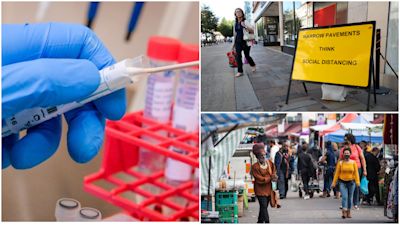Coronavirus R number remains above 1 across UK sparking concerns of national lockdown

The reproduction rate of coronavirus (R number) has increased to above 1.0 in virtually all parts of England - including London, the Midlands, North East and Yorkshire, the North West and South East regions.
The numbers suggest there is a risk that the overall coronavirus epidemic in the UK is increasing, not decreasing.
The growth rate of coronavirus transmission, which reflects how quickly the number of infections is changing day by day, has also increased slightly.
According to the government the official government R number for the UK is between 1.1 and 1.4.
What is the R value and why is the number one so important in stopping the spread of coronavirus?
Coronavirus: UK enters 'critical' weekend as Boris Johnson considers new national lockdown
An R number below 1.0 is crucial for scientists to have confidence that the prevalence of coronavirus is going down in Britain.
If the number is above 1.0 it means each person with the virus will pass it on to more than 1.0 person.
Regional R Numbers
England - 1.2-1.4
East of England - 1.0-1.3
London - 1.1-1.4
Midlands - 1.2-1.5
North East and Yorkshire - 1.2-1.4
North West - 1.2-1.5
South East - 1.1-1.4
South West - 0.9-1.6
If the R number is 1.1, it means each person with coronavirus is passing it to 1.1 people.
When the UK was under full national lockdown, ministers said the R number needed to be consistently below 1.0 before restrictions could be lifted.
The latest growth rate for the whole of the UK is between plus 2% to plus 7%, a dramatic change from between minus 1% to plus 3% last week.
The growth rate of coronavirus transmission reflects how quickly the number of infections is changing day by day.
Regional growth rates
England +3 to +7
East of England 0 to +5
London +3 to +7
Midlands +4 to +8
North East and Yorkshire +3 to +8
North West +3 to +8
South East +3 to +7
South West 0 to +9
Analysis from ITV News Health Producer Jonathan Mitchell
The fact that the R number has risen yet again will not surprise ministers, with a rise in coronavirus cases seen daily in official government figures.
The Office for National Statistics' own infection survey as well as Public Health England's surveillance study also point to a rise in Covid-19 cases.
What will concern public health officials is that even in areas that have been subject to local lockdown measures for some weeks now, particularly the North West, cases are still rising.
Even more worryingly, it's now happening across the whole of the UK.
The virus is simply becoming more difficult to contain by the day, and NHS Test and Trace - a key part of the government's strategy in doing so - has struggled under the first sign of pressure.
We've seen already that the government is not afraid to act quickly when faced with damning data, introducing the 'Rule-of-Six' last week to curb transmission in social settings.
But given the virus' incubation period, we won't see whether that's been effective for at least another week - this is a now crucial period in preventing a second wave.
It's worth remembering that the number of cases is still low, nowhere near the levels we had in March.
The virus can still be brought under control.
But if R number remains above 1, we can expect a weekly furthering in escalation of lockdown measures - and it won't just be in hotspots, but across the UK.
The latest R number figures come as a new national lockdown is being considered as a "last line of defence".
Senior UK ministers have said Britain enters a "critical weekend" in its fight against the coronavirus pandemic.
Health Secretary Matt Hancock said he hopes "local action" will be enough to bring infections rates down but added how full lockdown remains an option "on the table".
"The very last line of defence is national action", he said, "but of course we don't rule it out because this virus kills".